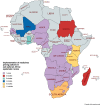Implementation of medicines pricing policies in sub-Saharan Africa: systematic review
- PMID: 36457058
- PMCID: PMC9714131
- DOI: 10.1186/s13643-022-02114-z
Implementation of medicines pricing policies in sub-Saharan Africa: systematic review
Abstract
Background: High medicine prices contribute to increasing cost of healthcare worldwide. Many patients with limited resources in sub-Saharan Africa (SSA) are confronted with out-of-pocket charges, constraining their access to medicines. Different medicine pricing policies are implemented to improve affordability and availability; however, evidence on the experiences of implementations of these policies in SSA settings appears limited. Therefore, to bridge this knowledge gap, we reviewed published evidence and answered the question: what are the key determinants of implementation of medicines pricing policies in SSA countries?
Methods: We identified policies and examined implementation processes, key actors involved, contextual influences on and impact of these policies. We searched five databases and grey literature; screening was done in two stages following clear inclusion criteria. A structured template guided the data extraction, and data analysis followed thematic narrative synthesis. The review followed best practices and reported using PRISMA guidelines.
Results: Of the 5595 studies identified, 31 met the inclusion criteria. The results showed thirteen pricing policies were implemented across SSA between 2003 and 2020. These were in four domains: targeted public subsides, regulatory frameworks and direct price control, generic medicine policies and purchasing policies. Main actors involved were government, wholesalers, manufacturers, retailers, professional bodies, community members and private and public health facilities. Key contextual barriers to implementation were limited awareness about policies, lack of regulatory capacity and lack of price transparency in external reference pricing process. Key facilitators were favourable policy environment on essential medicines, strong political will and international support. Evidence on effectiveness of these policies on reducing prices of, and improving access to, medicines was mixed. Reductions in prices were reported occasionally, and implementation of medicine pricing policy sometimes led to improved availability and affordability to essential medicines.
Conclusions: Implementation of medicine pricing policies in SSA shows some mixed evidence of improved availability and affordability to essential medicines. It is important to understand country-specific experiences, diversity of policy actors and contextual barriers and facilitators to policy implementation. Our study suggests three policy implications, for SSA and potentially other low-resource settings: avoiding a 'one-size-fits-all' approach, engaging both private and public sector policy actors in policy implementation and continuously monitoring implementation and effects of policies.
Systematic review registration: PROSPERO CRD42020178166.
Keywords: Medicine pricing policies; Policy implementation; Sub-Saharan Africa.
© 2022. The Author(s).
Conflict of interest statement
The authors declare that they have no competing interests.
Figures
References
-
- Teferra S, Hanlon C, Beyero T, Jacobsson L, Shibre T. Perspectives on reasons for non-adherence to medication in persons with schizophrenia in Ethiopia: a qualitative study of patients, caregivers and health workers. BMC Psychiatry. 2013;13(1):1–9. doi: 10.1186/1471-244X-13-168. - DOI - PMC - PubMed
Publication types
MeSH terms
Grants and funding
LinkOut - more resources
Full Text Sources
Research Materials
Miscellaneous



